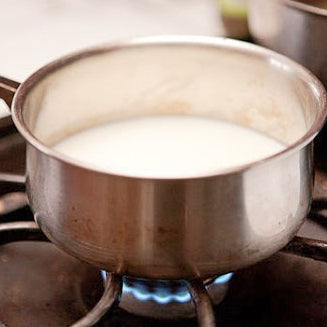
One of the biggest questions asked for those starting out is - Can you use milk straight out of the fridge or does it need to be warm / room temperature?
The short answer is that YES you can definitely use milk directly out of the fridge when making milk kefir.
Most people use milk directly out of the fridge as it is much more convenient and works well.
However a few people do warm up the milk to room temperature before making kefir.
There are 3 different ways to bring milk to room temperature for kefir
- Gently heat the milk on the stove until slightly warm or until its temperature is about room temperature.
- Let the milk sit out for hour or so until its naturally warmed up
- Lightly boil or pasteurize the milk and then let it cool down to room temperature.
The first method is the best in my opinion. Warm it up quickly and gently without pasteurizing it and without adding excess spoilage bacteria. It may still create more spoilage bacteria, but not as much as the 2nd method.
Letting the milk sit out until its at room temperature is not ideal as it can add excessive spoilage bacteria which may cause imbalances or bad tasting kefir.
Pasteurizing is not necessary, nor is it ideal. The more its pasteurized, the more sterile it becomes. That’s okay when making yogurt as it helps the weaker yogurt bacteria thrive better. With kefir that’s not necessary. Kefir grains have adapted to handle raw milk just fine with all that raw bacteria and enzymes fully intact.There’s no need to further pasteurize it.
However, there are some minor differences between kefir that is made with cold milk and kefir that is made with room temperature milk...
Historic Perspective
Traditionally, milk kefir was most likely made with fresh room temperature raw milk as they obviously did not have refrigeration. They did not warm up the milk, pasteurize or cook it in anyway. They simply used room temperature raw milk.
Taste difference
We’ve tasted the difference between cold milk and heated milk to room temperature and the taste after 24 hours is essentially the same under most conditions. It’s virtually indistinguishable.
Whey separation
When we tested, the grains with the warm milk did have a little more whey. It wasn’t too significant though and the impact was limited.

Jar on the left was from cold milk. Jar on the right was warmed up milk.
Grain growth
When we tested, we did notice a little more growth in the milk that was warmed up to room temperature. Anecdotally, other people have experience more growth as well. Perhaps the shock of the cold milk does stall the growth a little.
Thickness
No significant difference either. When we did our test, the thickness was very similar. If anything, the kefir made from cold milk was slightly thicker. This was likely due to it having a little less whey.
Bottom line
Yes, you can use milk directly out of the fridge and most people do that method when making kefir. However, there is some evidence to suggest that the cold milk does shock the grains a bit and may slow grain growth. Within 24 hours, they do recover and there's very little difference in flavor or thickness.
Warming up the milk may slightly help grain growth, but on the down side, it may cause more spoilage bacteria issues or make the milk become more sterile with pasteurization. So in the end, its probably not worth it unless you are looking to optimize growth rate.


Comments
Nora
Ha.. funny thing you said that they obviously had no refrigeration..
My grandma told me that her grandma who grew up on a farm remember how her parents were cooling milk.
The fresh milk was kept through the summer either immersed in a super cold well with almost ice cold water as it was always cold deep there, or the alternative method was
kind of amazing:
Ha.. funny thing you said that they obviously had no refrigeration..
My grandma told me that her grandma who grew up on a farm remember how her parents were cooling milk.
The fresh milk was kept through the summer either immersed in a super cold well with almost ice cold water as it was always cold deep there, or the alternative method was
kind of amazing:They would put the big pails of milk outside. IN THE SUN.. and covered it with plenty of rrugs and then they were pouring water on them regularly.. the process of evaporation of the water due to the sun heat was using emergy and cooling the milk under the wet rugs.
Ha.. funny thing you said that they obviously had no refrigeration..
My grandma told me that her grandma who grew up on a farm remember how her parents were cooling milk.
The fresh milk was kept through the summer either immersed in a super cold well with almost ice cold water as it was always cold deep there, or the alternative method was
kind of amazing:They would put the big pails of milk outside. IN THE SUN.. and covered it with plenty of rrugs and then they were pouring water on them regularly.. the process of evaporation of the water due to the sun heat was using emergy and cooling the milk under the wet rugs.I did try it once on a hot day and I really worked like a charm. who would think!
Ha.. funny thing you said that they obviously had no refrigeration..
My grandma told me that her grandma who grew up on a farm remember how her parents were cooling milk.
The fresh milk was kept through the summer either immersed in a super cold well with almost ice cold water as it was always cold deep there, or the alternative method was
kind of amazing:They would put the big pails of milk outside. IN THE SUN.. and covered it with plenty of rrugs and then they were pouring water on them regularly.. the process of evaporation of the water due to the sun heat was using emergy and cooling the milk under the wet rugs.I did try it once on a hot day and I really worked like a charm. who would think!So beg to differ .. yep they were clever and used the science and nature.
Ha.. funny thing you said that they obviously had no refrigeration..
My grandma told me that her grandma who grew up on a farm remember how her parents were cooling milk.
The fresh milk was kept through the summer either immersed in a super cold well with almost ice cold water as it was always cold deep there, or the alternative method was
kind of amazing:They would put the big pails of milk outside. IN THE SUN.. and covered it with plenty of rrugs and then they were pouring water on them regularly.. the process of evaporation of the water due to the sun heat was using emergy and cooling the milk under the wet rugs.I did try it once on a hot day and I really worked like a charm. who would think!So beg to differ .. yep they were clever and used the science and nature.In the winter of course the cold outside could be introduced to any part of the house
and create an area where the milk would be kept cold and fresh for a long time.
Ha.. funny thing you said that they obviously had no refrigeration..
My grandma told me that her grandma who grew up on a farm remember how her parents were cooling milk.
The fresh milk was kept through the summer either immersed in a super cold well with almost ice cold water as it was always cold deep there, or the alternative method was
kind of amazing:They would put the big pails of milk outside. IN THE SUN.. and covered it with plenty of rrugs and then they were pouring water on them regularly.. the process of evaporation of the water due to the sun heat was using emergy and cooling the milk under the wet rugs.I did try it once on a hot day and I really worked like a charm. who would think!So beg to differ .. yep they were clever and used the science and nature.In the winter of course the cold outside could be introduced to any part of the house
and create an area where the milk would be kept cold and fresh for a long time.Alternatively most people had a basements or separate ground storages outside of he house that were cold because they were undergrounds where it was always cold.
Most pats of old Eurpoe and Asia used these methods.
July 02, 2020
RK Remmen
My favorite technique is to put kefir grains in a jar with the milk straight from the fridge and then put the jar in a bowl of hot tap water. I remove the jar and cover it only after the hot water has cooled to about room temp; the kefir meanwhile has warmed to room temp. That assures me of a good ferment within 24 hours or less and consistent grain reproduction.
March 12, 2020
Leave a comment